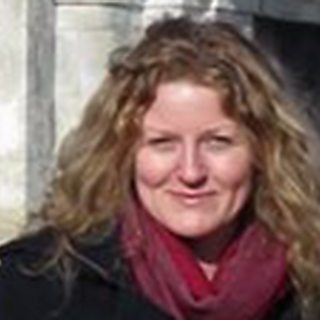In recent years the ���˿��� has been home to some of the most iconic programmes that focus on women: Call the Midwife, Fleabag, Happy Valley, Killing Eve, Gentleman Jack, I May Destroy You, Alma’s Not Normal and In My Skin. These productions have been celebrated for the challenges they pose to traditional representations of femininity. Additionally, many are written by women.
The past century has seen a transformation in the status and social position of women in the UK underpinned by the fight for equality. How has drama on the ���˿��� reflected these changes and perhaps even occasionally helped speed them up by taking a lead in social attitudes? How has it added to social debates associated with women such as work, family, sexuality and desire? And, crucially, what space has it provided for women to represent themselves? Here, we explore these issues, with a particular focus on the 1960s and 70s.
The ���˿���’s regular opened in 1936. In the early years dramas on television that were attributed to women writers were largely from stage plays or novels. For feminist-leaning playwrights like Clemence Dane and Aimee Stuart television, like radio before it, offered a space to explore the meaning of ‘woman’ and the social and environmental forces which shaped female experience. This was at a time when there was a close association with women and the home.
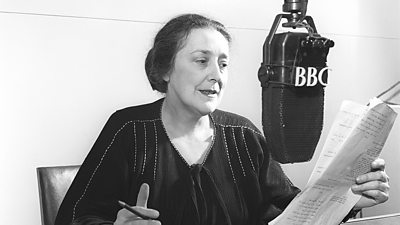
A studio production of Dane’s 1921 play, Will Shakespeare, a dramatic invention about the life of William Shakespeare, was first produced for television in 1938. Drawing on the popularity of The Bard as a symbol of British national identity, Dane used the play to foreground the significance of three women in Shakespeare’s life and their achievements in public life.
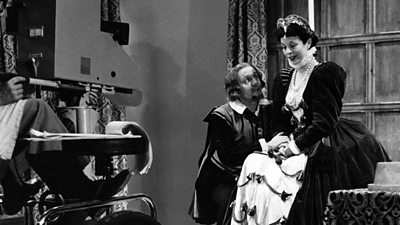
Nine Till Six is another feminist play of note. Written in 1930 by Aimée and Philip Stuart, the play had several radio productions before a studio version was produced for television in 1938.
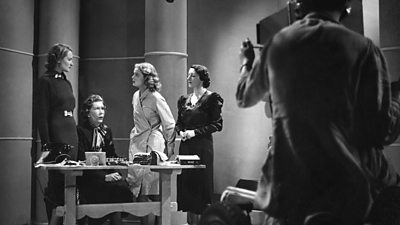
Set in a London dressmaker’s shop and with an all-female cast, the play paralleled the attitudes and experiences of working women of different social classes and between employer and employee, capturing something of the zeitgeist of the interwar period when, for most young women prior to marriage, work was an economic necessity. Unsurprisingly, the aspiration of all the women in the play was to marry. While this re-affirmed the accepted feminine destinies of the 1930s, it nonetheless foregrounded the bonds between women and the constraints imposed on their hopes and life choices.
Despite the success of their plays, women continued to make up less than a quarter of the ���˿���’s play-writers. However, by the 1950s, the expanding television service required more original material. The dearth of writers willing to write specifically for television offered new opportunities for women. Here, in an oral history interview for the British Entertainment History Project collection, the pioneering writer Hazel Adair recounts how she swapped acting for writing for television in the late 1940s:
Adair went on to pioneer the soap opera format on television and created and co-wrote, with Peter Ling, the ���˿���’s early soap opera Compact. This glamorous twice-weekly soap ran between 1962-1965. It was set in the offices of a woman’s magazine and formed part of the ���˿���’s revised programming strategy of the early 1960s that attempted to have stronger appeal to women and more youthful audiences with ‘modern’ aspirations.
Hazel Adair discusses where she received inspiration from Compact (1962-1965):
Despite the inroads made by women in television production, men still made up 88% of the drama writing workforce in the 1960s. Nonetheless play slots like ‘The Wednesday Play’, did engage with the changing attitudes and expectations of women brought about by the liberalising movements of this period.
For instance, plays such as Julia Jones’ A Designing Woman (1965), Dawn Pavitt and Terry Wale’s The Bond (1965), and Fay Weldon’s The Fall of the Goat (1967) questioned the very status of marriage as the route to fulfilment for the modern woman. This questioning is indicated in The Bond’s scene featuring the wedding ceremony.
In The Bond, Sally (the bride) gave up her job when she got married, as was the accepted convention. As this new ���˿��� oral history interview with Dame Joan Bakewell suggests, the realities of juggling a career as a successful broadcaster on ���˿��� Two’s Late Night Line Up, with her ‘other’ life as a wife and mother was challenging:
By the end of the 1960s, television drama had a new theme: the lives and aspirations of young single women who shared flats. The Liver Birds (1969) and It’s Awfully Bad for Your Eyes, Darling (1971), were comedies set in the swinging cities of Liverpool and London respectively with a focus on dating and having a good time.
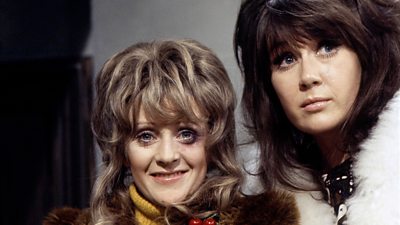
Both series reflected the late 1960s aspirations of a generation of women enjoying financial independence and, in the wake of abortion reform and the introduction of the pill, a newfound confidence in exploring their sexuality.
In The Liver Birds, created by Carla Lane and Myra Taylor, although frequent mention was made of the sexual desires of flatmates Beryl and Sandra, the scriptwriters preferred insinuation and innuendo rather than more realistic scenarios of sexual relationships.
It’s Awfully Bad for Your Eyes, Darling did contain more sexually explicit scenarios. Written by Jilly Cooper and Christopher Bond, It’s Awfully Bad for Your Eyes, Darling featured Joanna Lumley as Samantha, a pre-cursor to the role of Patsy in Absolutely Fabulous:
Flat-sharing was also the premise of a more bittersweet play series Take Three Girls, which began its twelve-week run on ���˿���1 in November 1969. The series paralleled the experiences of three flatmates of different social backgrounds: middle class single parent Kate (Susan Jameson), upper class but lonely Victoria (Liza Godard) and working-class secretary, Avril (Angela Down).

���˿��� One’s first colour drama, and with a chart-topping theme song Light Flight by The Pentangle, the promotional trailer for the series foregrounded it as an ’anthropological exploration’ of the experiences of young modern women.
It was the third play in the series, Avril: Devon Violets written by Julia Jones which was the most well-received with audiences and critics alike. A sensitive portrayal of Avril, an eighteen-year-old cockney and secretary, the move to the flat marked her social mobility away from the over-crowded family home and within it her mother, for whom no choice existed. Shot in the style of realist ‘kitchen sink’ drama, Avril’s confrontation with her mother about her desire to leave home unfolded in the cramped locale of the family’s scullery.
As well as addressing ‘modern’ issues, ���˿��� drama in the 1970s, began to engage directly with the ideas and anger that had informed the second-wave feminist movement. The 1974 historical drama, Shoulder to Shoulder was a landmark in this respect and is one of few programmes to be accorded its own special issue of Radio Times.
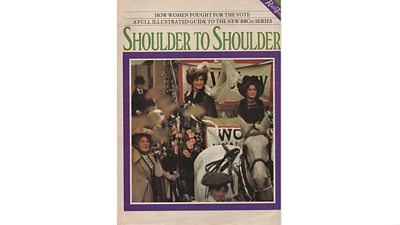
The six-part series historicised the long feminist fight for equality by telling the story of the early women’s suffrage movement in Britain. It was created by the film maker Midge Mackenzie and Actor Georgia Brown and produced by one of the few women television producers of the time, Verity Lambert.
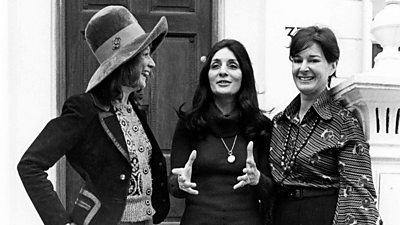
The resulting drama told the story of the militant suffragette movement headed by Emmeline Pankhurst (Sian Phillips) and her daughters Christabel (Patricia Quinn) and Sylvia (Angela Down). The series took pains to acknowledge the participation of women from all social ranks, from the Oldham mill girl Annie Kenney (Georgia Brown) to the high-born Lady Constance Lytton (Judy Parfitt). The series documented the period from 1898 to 1918, when the vote was partially won, and each of the feature-length episodes engaged with a significant moment in the militant suffrage campaign.
Episode one sees Christabel Pankhurst finding her voice and rousing public support for women’s suffrage.
Shoulder to Shoulder was broadcast in 1974, a year before the passing of the Sex Discrimination Act and at a time when the ���˿��� was itself under the spotlight for discriminatory practices, as the internal 1973 Women in the ���˿��� report had shown. One of those interviewed for the report was the Head of Drama Group in Television who commented that he "can count 11 women among his 85 producers and directors" and says "he would have more if becoming wives and mothers did not remove them from the scene. All his senior women are single or divorced".
Drama production in the 1970s remained dominated by men. Much to Mackenzie’s outrage, all six episodes of Shoulder to Shoulder were written by male writers. In a recent oral history interview Paula Milne remembers the difficulty of finding women writers for the slightly later series, Angels (1975-1983), about student nurses, and the deal which had to be cut with the producer in order to use them.
So on Angels, though I created it, I thought, ‘Well, the best people to write this is women.’ And there were virtually no women writers. Literally ... There was one called Julia Jones, who wasn’t young. There was Elaine Morgan, who wasn’t young. There was Fay Weldon. But no-one who would get down and dirty and write about student nurses. So I found a whole load of women writers: Jill Hyman, Anne Valery, people who’d done radio, who had been trying to get in, and various other people. And the producer said, for everyone woman writer … I made a deal with him. For every new writer, he said, in order to make sure the show happened he’d have to have one of his more experienced male writers. And that was OK. Two thirds were women, and that was pretty good.
The inequalities highlighted in Shoulder to Shoulder also featured in the prestigious drama strand Play for Today. Colin Welland’s powerful 1974 play Leeds – United! for example, dramatised the 1970 pay dispute in which more than 25,000 clothing workers in Yorkshire and the North East, the majority of them women, went on strike.
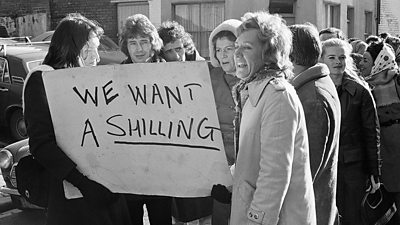
Female writers who did exist in the 1970s often tackled issues that specifically affected women. Nemone Lethbridge’s 1972 play Baby Blues, for instance, was on the theme of post-natal depression, a taboo subject in this period and was credited with starting up support groups for women affected by this condition. Rachel Billington’s Don’t Be Silly, broadcast in 1979, centred on domestic violence.
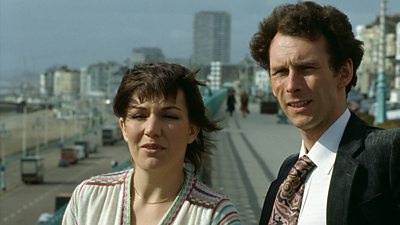
Play series of the 1970s also began to address more marginalised female identities, albeit not unproblematically. James Robson’s play, Girl, shown as part of the Second City First play series in February 1974, told of a love affair between Corporal Harvey (Myra Frances) and new recruit Jackie. Broadcast post-watershed on ���˿��� Two the play featured the first lesbian kiss on television. In this clip the women say their goodbyes as Jackie is discharged from the army.
Although the play attracted very little direct complaint, the audience research report suggested the play was not well received.
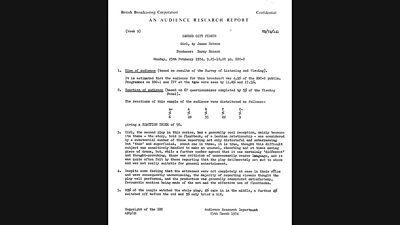
Certainly, the characterisation of Harvey as a predatory Corporal using her authoritative position to seduce new recruits in the woman’s army did little to help de-stigmatise lesbianism.
The 1970s also saw the first play written by and about the black female experience. Nigeria: A Kind of Marriage was written by acclaimed Nigerian-born writer, Buchi Emecheta. Akin to her celebrated1974 autobiographical novel Second Class Citizen, A Kind of Marriage explored the politics of marriage. Written for ���˿��� Two’s Centre Play series, it was set in Nigeria and told the story of Maria (Jumoke Debayo), a devoted wife and mother, whose loyalty to her husband was tested when she discovered he had fathered a son outside of their marriage.
Although the play deals with Nigerian tribal customs, Emecheta once described her stories to a journalist as "stories of the world…[where]… women face the universal problems of poverty and oppression, and the longer they stay, no matter where they have come from originally, the more the problems become identical."
These examples of television dramas from the 1930s to the 1970s, provide a glimpse of the mind-sets and ideas that were circulating about women and femininity in these earlier times. They show how the ���˿��� explored women’s status in society and also how they challenged and drove social change. The programmes are forerunners to the landmark series of 1980s and 1990s such as Tenko, South of the Border and Oranges are Not the Only Fruit when representations of women, by women, began to proliferate and diversify. And they form a direct line to the Fleabags and Gentleman Jacks’ of today.
Written by Dr Vicky Ball, Senior Lecturer in Cinema and Television Histories, De Montfort University with Dr Kate Murphy, Visiting Fellow at Bournemouth University.

